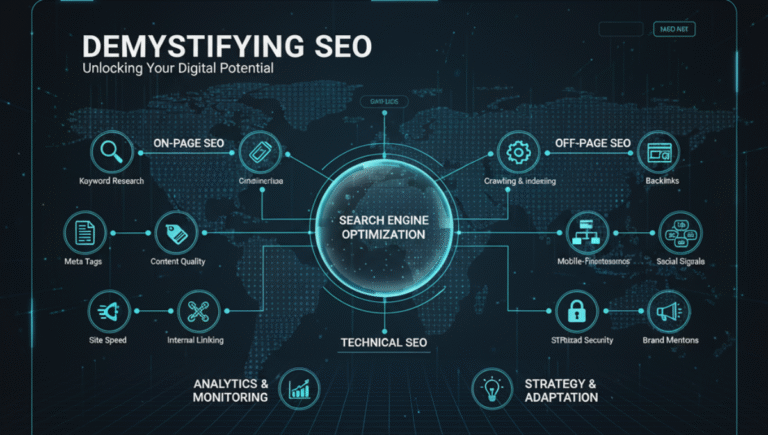In today’s digital age, having a strong online presence is essential for businesses, content creators, and entrepreneurs alike. One of the most effective ways to boost visibility, attract organic traffic, and grow your brand is through Search Engine Optimization (SEO). Despite its importance, SEO often appears complex and intimidating to newcomers. This guide aims to demystify SEO, breaking down its core concepts, strategies, and best practices to help you unlock its full potential.
What Is SEO? Understanding the Basics
Search Engine Optimization (SEO) is the process of enhancing your website or online content to improve its visibility on search engine results pages (SERPs). When users search for relevant keywords or phrases, SEO helps your content rank higher, increasing the likelihood of attracting targeted organic traffic.
Think of SEO as a way of making your website more appealing to search engines like Google, Bing, or Yahoo. The goal is to align your content with what users are searching for, ensuring your site appears at the top when it matters most.
Why Is SEO Important?
- Enhanced Exposure: Achieving top positions results in greater click-through rates and increased website visitors.
- Cost-Effective: Organic traffic reduces reliance on paid advertising.
- Trust and Credibility: Users tend to trust top-ranked sites more.
- Better User Experience: SEO encourages a user-friendly website structure.
- Long-Term Results: Unlike paid ads, SEO efforts can yield sustained organic growth.
How Search Engines Work
To understand SEO better, it’s crucial to grasp how search engines operate. Search engines use complex algorithms comprising three main processes:
- Crawling: Search engines send out bots (spiders) to discover new and updated content on the web.
- Indexing: Discovered pages are analyzed and stored in a massive database called an index.
- Ranking: When a user searches, search engines retrieve relevant pages from their index and rank them based on numerous factors.
Your goal with SEO is to optimize your site so that search engines can easily crawl, understand, and rank your content effectively.
Core Components of SEO
SEO encompasses various elements, broadly categorized into on-page, off-page, and technical SEO.
1. On-Page SEO
This involves optimizing individual pages to rank higher and earn more relevant traffic. Key aspects include:
- Keyword Research: Identifying the terms your target audience searches for.
- Content Quality: Creating valuable, informative, and engaging content.
- Meta Tags: Crafting compelling titles and meta descriptions with target keywords.
- Header Tags: Using H1, H2, H3 tags to structure content logically.
- URL Structure: Keeping URLs clean, descriptive, and keyword-rich.
- Internal Linking: Connecting related pages to improve navigation and authority flow.
- Image Optimization: Using descriptive alt text and compressing images for faster load times.
2. Off-Page SEO
This pertains to external factors that influence your site’s authority and ranking:
- Backlinks: Getting reputable sites to link to your content.
- Social Signals: Engagement on social media platforms.
- Brand Mentions: Mentions without links can also influence authority.
3. Technical SEO
Ensures your website meets the technical requirements for search engines:
- Site Speed: Faster websites rank better.
- Mobile-Friendliness: Responsive design for mobile users.
- Secure Protocols: HTTPS encryption.
- Sitemap and Robots.txt: Facilitating crawling and indexing.
- Structured Data: Using schema markup to enhance search listings.
Keyword Research and Optimization
Keywords are the foundation of SEO. Conduct thorough keyword research to identify:
- Search Volume: How often a term is searched.
- Keyword Difficulty: How competitive it is.
- Relevance: How well it matches your content.
Tools like Google Keyword Planner, Ahrefs, SEMrush, and Ubersuggest can assist in this process. Incorporate these keywords naturally into your content, titles, headers, and meta descriptions.
Creating SEO-Friendly Content
Content is king in SEO. To create content that ranks:
- Focus on user intent: Understand what users want when they search.
- Be comprehensive: Cover topics thoroughly.
- Use engaging formats: Text, images, videos, infographics.
- Update regularly: Keep content fresh and relevant.
- Optimize for readability: Use clear language and formatting.
Building Authority Through Backlinks
Backlinks remain a significant ranking factor. Strategies to earn quality backlinks include:
- Guest blogging on reputable sites.
- Creating shareable content like infographics or research reports.
- Building relationships with industry influencers.
- Participating in relevant forums and communities.
Avoid spammy link schemes; focus on earning links naturally through valuable content.
Measuring and Analyzing SEO Performance
Leverage platforms such as Google Analytics and Google Search Console to track and analyze:
- Organic traffic trends.
- Keyword rankings.
- Click-through rates (CTR).
- Bounce rates and engagement metrics.
- Technical issues affecting crawling and indexing.
Regular analysis helps refine your SEO strategies for better results.
Common SEO Mistakes to Avoid
- Keyword stuffing.
- Ignoring mobile optimization.
- Neglecting website speed.
- Duplicate content.
- Ignoring user experience.
- Focusing solely on search engines rather than users.
Prioritize creating value for your audience while adhering to best practices.
Staying Updated with SEO Trends
SEO is constantly evolving with search engine algorithm updates. Stay informed through:
- Industry blogs (Moz, Search Engine Journal, Neil Patel).
- Webinars and conferences.
- Participating in SEO communities.
Adapting to changes ensures your strategies remain effective.
Conclusion
Demystifying SEO reveals that it’s a multifaceted but accessible process centered around understanding your audience and search engines. By implementing best practices in on-page, off-page, and technical SEO, you can significantly enhance your website’s visibility, attract targeted traffic, and achieve your online goals. Remember, SEO is a long-term investment—patience, consistency, and continual learning are key to success.
